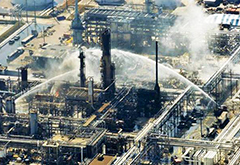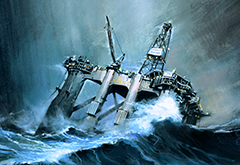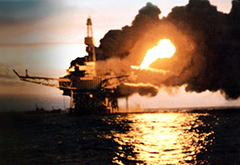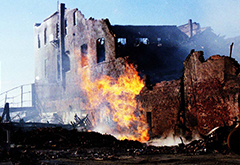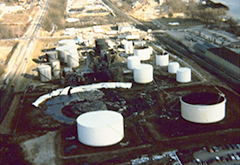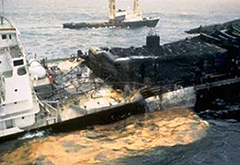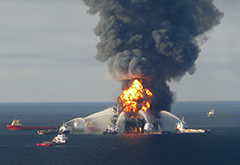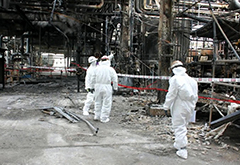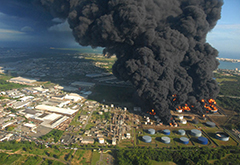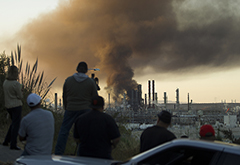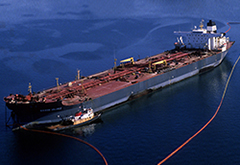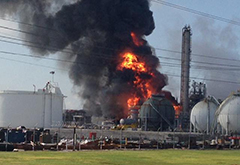1. BP's Texas City Refinery Disaster:
The Texas City Refinery explosion occurred on March 23, 2005, when a hydrocarbon vapor cloud was ignited and violently exploded at the ISOM isomerization process unit at BP's Texas City refinery in Texas City, Texas, killing 15 workers, injuring more than 180 others and severely damaging the refinery. The Texas City Refinery was the second-largest oil refinery in the state, and the third-largest in the United States with an input capacity of 437,000 barrels (69,500 m3) per day as of January 1, 2000. BP acquired the Texas county refinery as part of its merger with Amoco in 1999. More details
2. Ocean Ranger Disaster:
Ocean Ranger was a semi-submersible mobile offshore drilling unit that sank in Canadian waters on 15 February 1982. It was drilling an exploration well on the Grand Banks of Newfoundland, 267 kilometres (166 mi) east of St. John's, Newfoundland, for Mobil Oil of Canada, Ltd. with 84 crew members on board when it sank. There were no survivors. On 26 November 1981, Ocean Ranger commenced drilling well J-34, its third well in the Hibernia Oil Field. Ocean Ranger was still working on this well in February 1982 when the incident occurred. Two other semi-submersible platforms were also drilling nearby: Sedco 706, 8.5 miles NNE, and Zapata Ugland, 19.2 miles N of Ocean Ranger. More details
Ocean Ranger was a semi-submersible mobile offshore drilling unit that sank in Canadian waters on 15 February 1982. It was drilling an exploration well on the Grand Banks of Newfoundland, 267 kilometres (166 mi) east of St. John's, Newfoundland, for Mobil Oil of Canada, Ltd. with 84 crew members on board when it sank. There were no survivors. On 26 November 1981, Ocean Ranger commenced drilling well J-34, its third well in the Hibernia Oil Field. Ocean Ranger was still working on this well in February 1982 when the incident occurred. Two other semi-submersible platforms were also drilling nearby: Sedco 706, 8.5 miles NNE, and Zapata Ugland, 19.2 miles N of Ocean Ranger. More details
3. Piper Alpha Disaster:
Piper Alpha was an oil platform located in the North Sea approximately 120 miles (190 km) north-east of Aberdeen, Scotland. It was operated by Occidental Petroleum (Caledonia) Limited and began production in 1976, initially as an oil-only platform but later converted to add gas production. An explosion and resulting oil and gas fires destroyed Piper Alpha on 6 July 1988, killing 167 men, including two crewmen of a rescue vessel; 61 workers escaped and survived. Thirty bodies were never recovered. The total insured loss was about £1.7 billion, making it one of the costliest man-made catastrophes ever. At the time of the disaster, the platform accounted for approximately ten percent of North Sea oil and gas production. More details
4. Hutchinson Gas Disaster:
On January 17, 2001, 143 million cubic feet (4,000,000 m3) of compressed natural gas leaked from the nearby Yaggy storage field. It sank underground, then rose to the surface through old brine or salt wells, making around 15 gas blowholes. An explosion in the downtown area at 10:45 am destroyed two businesses and damaged 26 others. An explosion the next day in a mobile-home park killed two people. The Kansas National Guard was called in to help evacuate parts of the city because of the gas leaks, and a team of specialists looked over all the city for leaks after the event. These events were broadcast on nationally televised news stations across the country. More details
5. Ashland Oil Spill Disaster:
The Ashland oil spill was an oil spill that occurred on January 2, 1988 into the Monongahela River near the town of Jefferson Hills, Pennsylvania, approximately 20 miles upstream from the city of Pittsburgh. Ashland Oil Company Inc. (currently known as Ashland Inc.) owned a facility near the Monongahela River in Jefferson, PA (now Jefferson Hills). On January 2, 1988, a four-million gallon tank was used for the first time after being dismantled (from an Ohio location) and rebuilt in Pennsylvania. It was this tank, holding approximately 3.5 million gallons of diesel oil, that failed and collapsed, dumping nearly 1 million gallons of the oil into a storm sewer that led to the Monongahela River. More details
6. St. Louis Gas Cylinders Disaster:
On June 24, 2005, fire swept through thousands of flammable gas cylinders at the Praxair gas repackaging plant in St. Louis, Missouri. Dozens of exploding cylinders were launched into the surrounding community and struck nearby homes, buildings, and cars, causing extensive damage and several small fires. Seventy firefighters were called, but they could not get within several blocks of the fire for four hours, officials said. The heat could be felt a quarter of a mile away. "Incredibly, no one needed to be transported to a hospital," Kim Bacon, public information officer for the St. Louis Fire Department, said Friday evening. More details
7. Puerto Rican Tanker Disaster:
The SS Puerto Rican, was an American-flagged tanker disabled by an explosion on October 31, 1984. The 20,295 GRT, 632 ft (192.6 m), tanker was owned by Bankers Trust Company and operated by Keystone Shipping Co. of Philadelphia which burned in an explosion with the stern section sinking just hours after leaving San Francisco bound for New Orleans with a cargo of 91,984 barrels of lubricating oil and additives. In addition to the cargo the ship was fueled with 8,500 barrels of Heavy Fuel Oil (Bunker C) before departure. More details
8. Deepwater Horizon Disaster:
Deepwater Horizon was an ultra-deepwater, dynamically positioned, semi-submersible offshore drilling rig owned by Transocean. Built in 2001 in South Korea by Hyundai Heavy Industries, the rig was commissioned by R&B Falcon (a later asset of Transocean), registered in Majuro, and leased to BP from 2001 until September 2013. In September 2009, the rig drilled the deepest oil well in history at a vertical depth of 35,050 ft (10,683 m) and measured depth of 35,055 ft (10,685 m) in the Tiber Oil Field at Keathley Canyon block 102, approximately 250 miles (400 km) southeast of Houston, in 4,132 feet (1,259 m) of water. More details
9. Pryor Trust Gas Well Disaster:
Pittsburg County Sheriff Chris Morris said Jan 23, 2018 that the five workers missing after an explosion and fire at a well site in Oklahoma are now presumed dead, and the search has shifted from rescue to recovery, the Associated Press reports. Three of the missing are employees of Houston-based Patterson-UTI Energy Inc. (Nasdaq: PTEN), according to Reuters and KFOR Oklahoma’s News 4. Of the 22 workers at the site, one was treated for burns, and 16 did not have major injuries. The explosion occurred around 9 a.m. Jan. 22, causing a fire that burned for several hours and spread to surrounding areas, per the reports. More details
10. Tesoro Anacortes Refinery disaster:
The 2010 Tesoro Anacortes Refinery disaster was an industrial accident that occurred at the Tesoro Anacortes Refinery in Anacortes, Washington on April 2, 2010. Seven workers received fatal burns in an explosion and ensuing fire when a heat exchanger violently ruptured after a maintenance restart. At 12:30 a.m. on April 2, while personnel were performing post-maintenance heat exchanger restart operations, a heat exchanger on an adjacent bank catastrophically and violently ruptured. The pressure-containing shell of the heat exchanger burst at its weld seams, expelling a large volume of very hot hydrogen and naphtha, which spontaneously ignited upon contact with the surrounding air. More details
11. Cataño Oil Refinery Disaster:
The 2009 Cataño oil refinery fire was a fire that began with an explosion on October 23, 2009, and was extinguished on October 25 at the Caribbean Petroleum Corporation (CAPECO) oil refinery and oil depot in Bayamón, Puerto Rico. While the fire and subsequent explosion occurred close to the city of Cataño, it technically occurred within the borders of Bayamón, even though Cataño was more affected by fumes and evacuation. There were no fatalities, but 3 people were injured. The initial explosion destroyed eleven storage tanks at the facility, but quickly spread to other nearby tanks. The tanks contained gasoline, jet fuel, and diesel. More details
12. Chevron Richmond Refinery Disaster:
The Chevron Richmond Refinery is a 2,900-acre (1,200 ha) petroleum refinery in Richmond, California, on San Francisco Bay. It is owned and operated by Chevron Corporation and employs more than 1,200 workers, making it the city's largest employer. The refinery processes approximately 240,000 barrels (38,000 m3) of crude oil a day in the manufacture of petroleum products and other chemicals. The refinery's primary products are motor gasoline, jet fuel, diesel fuel and lubricants. On August 6, 2012, a large fire erupted at the refinery at about 6:15 PM and reported to be contained at 10:40 PM. Flames were seen issuing from at least two of the refinery's towers. More details
13. Exxon Valdez Oil Spill Disaster:
The Exxon Valdez oil spill occurred in Prince William Sound, Alaska, March 24, 1989, when Exxon Valdez, an oil tanker owned by Exxon Shipping Company, bound for Long Beach, California, struck Prince William Sound's Bligh Reef, 1.5 mi (2.4 km) west of Tatitlek, Alaska, at 12:04 a.m. and spilled 10.8 million US gallons (257,000 bbl) (or 37,000 tonnes) of crude oil over the next few days. It is considered the worst oil spill worldwide in terms of damage to the environment. The Valdez spill is the second largest in US waters, after the 2010 Deepwater Horizon oil spill, in terms of volume released. More details
14. Sansinena Oil Tanker Disaster:
SS Sansinena was a Liberian oil tanker that exploded in Los Angeles harbor on 17 December 1976. She was docked at berth 46 at Port of Los Angeles in San Pedro, California. The vessel was a steamship built in 1958. At its final port of call, Sansinena had discharged its cargo of crude oil and was taking on ballast and fuel when a massive explosion split the ship in half and obliterated multiple port buildings. The blast shattered windows for miles around and triggered a fire that spread across the dock and around the tanker. The Los Angeles Fire Department soon arrived on the scene to contain the blaze and rescue survivors. More details
15. Williams Olefins Plant Explosion:
The Williams Olefins Plant explosion occurred on June 13, 2013 at a petrochemical plant located in Geismar, an unincorporated and largely industrial area 20 miles (32 km) southeast of Baton Rouge, Louisiana. Two workers were killed and 114 injured. The U.S. Occupational Safety and Health Administration (OSHA) and the U.S. Chemical Safety and Hazard Investigation Board (CSB) launched investigations to determine how and why the heat exchanger failed. The Chemical Safety Board concluded that a standby heat exchanger had filled with hydrocarbon. This heat exchanger was isolated from its pressure relief; shortly after the heat exchanger was heated with hot water, the hydrocarbon flashed to vapor, ruptured the heat exchanger, and exploded. More details

